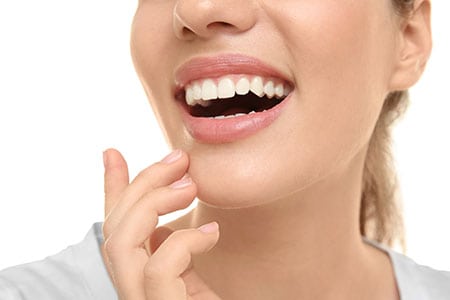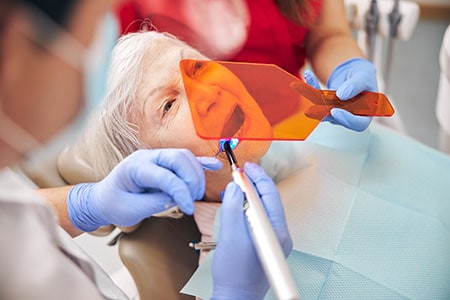Tooth Bonding In Toledo In Sylvania
Serving Our Dental Patients at Our Office in Sylvania

Tooth bonding in Sylvania is among the easiest and least expensive of cosmetic dental procedures. It can yield dramatic results in a single office visit. The treatment involves applying a plastic or resin material to the portion of the tooth structure that shows most prominently when you smile. This material can be used to improve the tooth shape or size, or to conceal small dental imperfections. The results look very natural and can last for many years with the proper care and attention.
Tooth bonding can accomplish a variety of cosmetic objectives, including the following:
- Close unsightly gaps in teeth
- Repair chipped/cracked teeth or a broken tooth
- Straighten crooked teeth
- Repair decayed teeth
- Lighten stains on teeth
- Improve appearance of discolored teeth
- Make teeth look longer
- Protect a portion of the tooth’s root that has been exposed when gums recede
Tooth Bonding Treatment Procedure
Dental bonding is popular and well tolerated for a few reasons: it is inexpensive, fast and can be conveniently completed in a single appointment. There is minimal preparation needed and no anesthesia is required.
Before the bonding material is applied to the tooth, the gums are protected and a special phosphoric acid solution is applied to the surface of the natural teeth. This solution etches the teeth similar to the way sandpaper roughs up a surface. After the acid has been on the teeth for about 15 seconds, it is removed.

Then, a thin coating of putty-like plastic or resin is applied over the front surface of the teeth. The coating comes in many shades to match your natural teeth. The bonding material is sculpted and shaped to the desired specifications; to either conceal a small dental imperfection (e.g., chip, crack) or improve the shape, size or length of the tooth. A high-intensity curing light is directed at the bonding material to harden it. The process may be repeated if needed. Finally, the tooth surface is buffed and polished to give it a beautiful translucence. The bonding should be indistinguishable from the natural tooth enamel. The bonded teeth are uniform in shape and size with the natural teeth. With the proper care and attention, bonding results can last for years.
Tooth Bonding FAQ
Am I too old or young for tooth bonding?

There are no age requirements or age limits for tooth bonding. The composite bonding material addresses many tooth problems that may happen to children and adults of all ages. For example, a child who suffers a mouth injury that chips or cracks a tooth will qualify for dental bonding to restore the function and appearance of the damaged tooth. A senior, or someone over 65, may have teeth bonding to close gaps between their teeth that pose a risk for cavities or gum disease.
While there are no age restrictions for dental bonding, the longevity of these restorations depends on good dental hygiene and the circumstances of the tooth issue, such as a young child with a damaged tooth that hasn’t fully erupted. Our dentists may recommend tooth bonding or another restorative option based on your unique needs.
Is teeth bonding painful?
No, tooth bonding typically does not cause pain. The material is adhered to the natural tooth structure and does not work close to the nerve inside the tooth. Our dentists may use anesthesia for your comfort, but this may not be necessary. Some people may experience temporary tooth sensitivity after the bonding material, but over-the-counter pain medicines can ease the discomfort.
What are the benefits of tooth bonding?
Composite bonding is a cost-effective dental procedure that addresses a range of tooth concerns, including severe tooth discoloration, tooth gaps, chipped teeth, and cracked teeth. It’s a versatile material, and the process is faster and more convenient than other options, such as dental crowns or porcelain veneers. The process for tooth bonding requires only one visit to our Sylvania office, unlike crowns and veneers, which take at least two visits. Dental bonding is minimally invasive and usually doesn’t require tooth reduction, unlike other restorations requiring enamel removal to make room for a cap or shell.
What are the risks of tooth bonding?

The dental bonding material may not resist stains as effectively as restorations made with ceramic or porcelain. You can ensure the material keeps its natural-looking sheen and shade with daily brushing and flossing and avoiding foods and beverages known to cause tooth discoloration, such as red wine and tea.
Teeth bonding may not last as long as dental crowns or porcelain veneers, which may last 10 to 20 years before they need replacing. However, many patients enjoy their dental bonding results for up to 10 years with proper oral hygiene and regular teeth cleanings. Be sure to avoid habits that may chip the bonding material, such as chewing on pens, biting fingernails, or using your teeth as tools to open packaging.
What should I expect after teeth bonding?
There’s no downtime or recovery needed after a teeth bonding appointment. You can eat and drink normally and enjoy all your normal activities. Your tongue and lips may feel different when you close your mouth, which could affect your speech for a few hours as you get used to the new feel of the tooth. Some patients may experience temporary sensitivity after dental bonding.
Contact Our Toledo Dentists
The team at Dental Health Associates offers a wide range of cosmetic dentistry treatments to suit nearly every patient’s needs. For a smile that’s truly a work of art, come to the best dental office in the Toledo area — Dental Health Associates! Contact us today to schedule an informational appointment.


